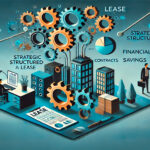A well-structured leasing agreement is more than a financial tool—it’s a strategic advantage for businesses. Whether leasing equipment, vehicles, or property, businesses can use leases to maintain financial flexibility, minimize upfront costs, and keep their operations adaptable. The key lies in designing lease agreements that are aligned with long-term business goals, ensuring the agreement supports growth, efficiency, and risk management.
Understanding how to structure a lease effectively begins with knowing the elements of a lease, the flexibility it offers, and how to negotiate terms that maximize benefits.
Balancing Lease Terms and Flexibility
One of the first considerations in a leasing agreement is the lease term, which determines the duration of the contract. Shorter lease terms may offer more flexibility, allowing businesses to upgrade equipment or exit the lease as needs change. However, longer terms often come with the advantage of lower monthly payments, making them ideal for companies that plan to use the leased asset for an extended period.
For businesses experiencing rapid growth or dealing with fluctuating market conditions, flexibility is essential. Structured correctly, leases can include early termination options, allowing a business to exit the agreement without severe penalties if conditions change. Negotiating these types of terms upfront helps ensure that businesses remain agile, regardless of future uncertainties.

Negotiating Favorable Payment Terms
Monthly payment structures should be designed to match the financial flow of the business. Predictable, fixed payments help companies manage cash flow more effectively, providing clear expectations for budget planning. However, businesses experiencing seasonal fluctuations may benefit from customized payment terms that align with their busiest periods.
Leasing agreements can be structured to include various payment options, such as paying lower amounts during slower periods and higher payments during peak revenue seasons. This ensures that businesses are not overburdened with lease costs when revenue is lean. The goal is to design payments that offer stability and financial predictability.
Tax Benefits and Financial Planning
Leasing offers several tax advantages that can improve a business’s financial position. Lease payments are often treated as operating expenses, which means they are typically tax-deductible. This reduces a business’s overall tax burden, offering an additional financial incentive compared to buying outright, where only depreciation and interest may be deducted.
It’s important for businesses to consult with tax professionals when structuring their leases, as this ensures the company takes full advantage of any available tax deductions. Understanding whether a lease will be classified as an operating lease or a capital lease is essential for maximizing tax benefits.
Mitigating Risk Through Maintenance Clauses
Many leasing agreements include provisions for maintenance and repairs. This can be a major benefit for businesses, as the lessor is often responsible for ensuring the equipment or property remains in working condition. By transferring the responsibility for maintenance and repairs to the lessor, businesses can reduce unexpected costs and avoid downtime due to equipment failures.
Structured properly, the leasing agreement can include detailed service-level agreements (SLAs) that ensure timely repairs and maintenance. This protects the business from operational disruptions and financial strain caused by equipment breakdowns.
Leveraging Upgrade and Renewal Options
For businesses relying on cutting-edge technology or equipment, a well-structured leasing agreement should include options for upgrading or renewing the lease at favorable terms. This allows businesses to access the latest advancements in technology without the need to buy new equipment outright.
At the end of the lease term, businesses can renegotiate for newer models or more advanced systems, ensuring they remain competitive. Structured upgrade options prevent companies from being tied to outdated or less efficient equipment that can slow down operations or increase costs over time.

Aligning Leasing Agreements with Long-Term Strategy
Ultimately, the best leasing agreements are those that align with the company’s long-term strategy. Leasing is not just a way to save on upfront costs—it’s a tool to support business growth, improve operational efficiency, and reduce financial risks. When structuring a lease, consider how it fits into the broader goals of the business, whether that’s scaling up, innovating with new technology, or entering new markets.
A well-structured lease should provide the flexibility to grow or adapt to changing market conditions, while still offering financial advantages like predictable payments and tax benefits.
Conclusion
Structuring leasing agreements for maximum business benefit involves understanding the key elements of the lease, negotiating flexible terms, and aligning the lease with long-term goals. By balancing the lease term, payment structure, tax benefits, and maintenance responsibilities, businesses can create leases that not only provide immediate financial relief but also support long-term success. A well-structured lease helps businesses stay competitive, agile, and financially stable in a constantly changing market.









